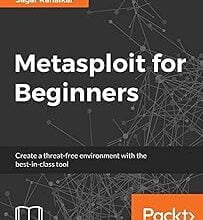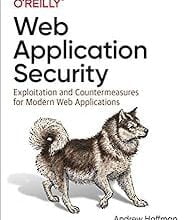
Metasploit: The Penetration Tester's Guide
by David Kennedy, Jim O'Gorman, Devon Kearns, and Mati Aharoni
Hey, BugBusters! Are you ready to dive into the world of penetration testing? Let’s discuss Metasploit: The Penetration Tester’s Guide by David Kennedy, Jim O’Gorman, Devon Kearns, and Mati Aharoni. This book is an absolute gem for anyone looking to master the art of penetration testing using the robust Metasploit framework.
Whether you’re a millennial just starting in cybersecurity or a seasoned pro looking to sharpen your skills, this guide has something for everyone. It’s packed with practical tips, hands-on exercises, and real-world examples that make learning fun and effective. The authors break down complex concepts into easily digestible parts, making them accessible for beginners while still offering advanced insights for experienced professionals.
So, if you’re passionate about cybersecurity and eager to learn how to test and strengthen security infrastructures, Metasploit: The Penetration Tester’s Guide is the book for you. Let’s explore why this guide is necessary for anyone serious about ethical hacking and penetration testing!
About the Authors
David Kennedy is a well-known figure in the cybersecurity world, with extensive experience in penetration testing and ethical hacking. He is the founder of TrustedSec and Binary Defense Systems, and his expertise has been showcased in various media outlets and conferences. Kennedy’s dedication to advancing cybersecurity practices has made significant contributions to the field.
Jim O’Gorman brings a wealth of knowledge in information security and digital forensics. He is known for his work with Offensive Security, where he helps shape the next generation of cybersecurity professionals. O’Gorman’s experience and commitment to education are evident in his contributions to various training programs and resources.
Devon Kearns is a seasoned security professional with a strong background in penetration testing and secure programming. His work with Offensive Security and the Metasploit framework has been instrumental in developing practical, hands-on security training. Kearns’ ability to break down complex concepts into understandable lessons has made him a valuable educator in the cybersecurity community.
Mati Aharoni is the creator of Kali Linux, a widely used penetration testing platform, and a co-founder of Offensive Security. His contributions to the field include developing tools and resources that are essential for ethical hackers and security professionals. Aharoni’s innovative work has significantly impacted how cybersecurity training is conducted.
Together, Kennedy, O’Gorman, Kearns, and Aharoni bring unparalleled expertise and experience to Metasploit: The Penetration Tester’s Guide. Their combined knowledge and practical insights make this book an invaluable resource for anyone looking to enhance their penetration testing and cybersecurity skills.
Overview of the Book
Metasploit: The Penetration Tester’s Guide is a comprehensive manual dedicated to teaching the ins and outs of the Metasploit framework, one of the most powerful tools available for penetration testing. The authors—David Kennedy, Jim O’Gorman, Devon Kearns, and Mati Aharoni—focus on equipping readers with the knowledge and skills necessary to use Metasploit effectively for testing and securing systems.
Metasploit Framework: The book delves deep into the functionalities of the Metasploit framework, explaining how to exploit vulnerabilities in various systems and applications. Readers learn how to navigate the Metasploit interface, configure and execute exploits, and interpret the results. The guide covers many exploits and payloads, providing readers with a solid foundation in using Metasploit for different scenarios.
Applications in Penetration Testing: Much of the book is dedicated to applying Metasploit in real-world penetration testing. The authors walk readers through the entire penetration test process, from information gathering and vulnerability scanning to exploitation and post-exploitation activities. Using detailed examples and case studies, the book demonstrates how to leverage Metasploit effectively to uncover and address security weaknesses.
Comprehensive Technical Skills: The guide is structured to build comprehensive technical skills, starting with the basics and progressing to more advanced topics. Early chapters focus on fundamental concepts such as network scanning and enumeration, while later sections delve into complex techniques like developing custom exploits and using Metasploit’s advanced features. This progression ensures that readers of all skill levels can benefit from the book.
Ethical Considerations: Besides technical skills, the book emphasizes the importance of ethical hacking. The authors stress the responsible and legal use of penetration testing tools, providing guidelines for obtaining proper authorization and conducting tests that respect privacy and legal boundaries. This focus on ethics ensures that readers understand the broader implications of their work and the importance of maintaining professional integrity.
Hands-On Exercises and Practical Insights: Metasploit: The Penetration Tester’s Guide is packed with hands-on exercises that reinforce the theoretical knowledge presented in each chapter. These practical activities allow readers to apply what they’ve learned in a controlled environment, gaining valuable experience using Metasploit. Including real-world examples and scenarios makes the material engaging and relevant, helping readers understand the practical applications of their skills.
Focusing on the functionalities and applications of the Metasploit framework and providing comprehensive technical skills and ethical considerations, this book equips readers with the tools they need to conduct responsible and effective penetration testing. Metasploit: The Penetration Tester’s Guide is an essential resource for anyone serious about mastering the art of ethical hacking and cybersecurity.
Key Highlights
Metasploit Basics: The book starts with a solid introduction to the Metasploit framework, covering its installation, setup, and primary usage. This section is perfect for beginners, as it walks readers through the fundamental features of Metasploit, such as navigating the console, understanding the different modules, and executing simple exploits. The clear and concise explanations make it easy for newcomers to get up to speed quickly.
Exploit Development: One of the standout sections is dedicated to exploiting development. Here, the authors dive deep into creating custom exploits using Metasploit. They cover the anatomy of an exploit, how to identify vulnerabilities, and the steps required to develop and test an exploit. This chapter is precious for more experienced users who want to enhance their skills and develop unique exploits tailored to specific targets.
Advanced Techniques: The book doesn’t stop at the basics; it also covers advanced penetration testing techniques. This includes pivoting through networks, using Metasploit for post-exploitation activities, and automating tasks with scripts and plugins. These chapters give readers a deeper understanding of leveraging Metasploit’s full capabilities, making it a versatile tool for comprehensive security assessments.
Practical Applications and Real-World Examples: “Metasploit: The Penetration Tester’s Guide” is rich with practical applications and real-world examples. The authors include numerous case studies illustrating how to apply Metasploit in different penetration testing scenarios. These examples help bridge the gap between theory and practice, showing readers how to use Metasploit to uncover vulnerabilities, exploit them, and ultimately secure systems. The hands-on exercises throughout the book reinforce learning and provide readers with valuable experience.
Interactive Labs: Another highlight is the inclusion of interactive labs that accompany each chapter. These labs are designed to give readers hands-on experience with Metasploit, guiding them through real-world tasks such as scanning networks, exploiting vulnerabilities, and conducting post-exploitation activities. By working through these labs, readers can apply the concepts they’ve learned in a controlled environment, gaining practical skills directly applicable to their professional work.
Ethical Hacking Focus: The book emphasizes the importance of ethical hacking, providing guidelines for conducting penetration tests responsibly and legally. The authors stress the need for proper authorization and adherence to legal and moral standards, ensuring readers understand their work’s broader implications. This focus on ethics is crucial for developing a professional approach to penetration testing.
Delving into these specific chapters and sections and highlighting the practical applications and real-world examples, Metasploit: The Penetration Tester’s Guide provides a comprehensive and engaging learning experience. These features reinforce learning and ensure that readers are well-equipped to apply penetration testing techniques in their professional work, making cybersecurity both accessible and exciting.
Why It’s Recommended for Cybersecurity Professionals
Objective and Content: Discuss the book’s utility for novices and experienced cybersecurity professionals. Explain how it offers a foundational understanding of the Metasploit framework while providing practical strategies for effective penetration testing. Emphasize the hands-on knowledge and practical tools it offers.
“Metasploit: The Penetration Tester’s Guide” by David Kennedy, Jim O’Gorman, Devon Kearns, and Mati Aharoni is highly recommended for cybersecurity professionals at all levels, and here’s why:
Utility for Novices: This book serves as an excellent introduction to the Metasploit framework for those new to cybersecurity. The authors break down complex concepts into simple, easy-to-understand language, making it accessible for beginners. The chapters on Metasploit basics and initial setup provide a solid foundation, ensuring that novices can get up and running quickly. The hands-on exercises and interactive labs reinforce learning, allowing beginners to apply what they’ve learned in a controlled environment.
Value for Experienced Professionals: This guide will also be immensely valuable to experienced cybersecurity professionals. It delves deep into advanced penetration testing techniques and provides updated strategies for exploiting and securing systems using Metasploit. The detailed explanations of exploit development, post-exploitation activities, and network pivoting offer advanced insights that help seasoned professionals refine their skills. The real-world examples and case studies provide practical applications experienced testers can immediately integrate into their workflows.
Foundational Understanding and Practical Strategies: Metasploit: The Penetration Tester’s Guide is meticulously structured to help readers gain a comprehensive understanding of the Metasploit framework. Each chapter builds on the previous one, ensuring readers develop a solid foundation for using Metasploit for penetration testing. The authors provide practical strategies for conducting thorough and effective penetration tests, making the material relevant and applicable. This combination of foundational knowledge and useful insights significantly enhances the readers’ ability to identify and address security vulnerabilities.
Hands-on Knowledge and Practical Tools: One of the book’s standout features is its emphasis on hands-on learning. Sikorski and Honig include numerous practical exercises and real-world examples that allow readers to apply theoretical knowledge in a practical context. These exercises help readers develop the skills needed to perform effective malware analysis. The book also offers practical tools and best practices for using debuggers, disassemblers, network analyzers, and other essential software. This comprehensive toolkit equips readers with the necessary resources to tackle real-world malware challenges.
Ethical Considerations: The book emphasizes the importance of ethical hacking, providing guidelines for conducting penetration tests responsibly and legally. The authors stress the need for proper authorization and adherence to legal and moral standards, ensuring readers understand their work’s broader implications. This focus on ethics is crucial for developing a professional approach to penetration testing.
In summary, Metasploit: The Penetration Tester’s Guide is an invaluable resource for cybersecurity professionals at all levels. It offers a solid foundation for novices, advanced insights for experienced practitioners, and practical tools for dealing with real-world cybersecurity challenges. By providing comprehensive coverage of the Metasploit framework and practical strategies for effective penetration testing, this guide ensures readers can enhance their cybersecurity skills and apply them effectively in their professional work.
Engagement and Learning Path
Objective and Content: Encourage readers to view this book as integral to their ongoing ethical hacking and cybersecurity education. Suggest engaging with community forums, participating in relevant workshops, and practicing the techniques outlined in the book in controlled environments.
As you immerse yourself in Metasploit: The Penetration Tester’s Guide, seeing this book as a critical component of your continuous education in ethical hacking and cybersecurity is essential. Here’s how to make the most out of your learning journey:
Engage with Community Forums: Join online forums and discussion groups dedicated to penetration testing and cybersecurity. Platforms like BugBustersUnited, Reddit, Stack Exchange, and specialized cybersecurity forums are excellent places to discuss concepts from the book, ask questions, and share experiences. Engaging with these communities can offer diverse perspectives, deepen your understanding, and help you apply the techniques more effectively.
Participate in Relevant Workshops: Look for workshops, webinars, and ethical hacking and penetration testing training sessions. These events often feature hands-on labs and real-world scenarios that complement the material covered in the book. Participating in these workshops allows you to practice the techniques in a guided setting and learn from industry experts and peers.
Practice in Controlled Environments: Set up your lab environment or use online platforms like Hack The Box, TryHackMe, or other cybersecurity labs to practice the techniques outlined in the book. Controlled environments provide a safe space to experiment with different hacking tools and strategies without risking real-world systems. This hands-on practice is crucial for internalizing the knowledge and developing the skills needed to perform practical penetration tests.
Continuing the Learning Journey: Ethical hacking and cybersecurity are dynamic fields with constant advancements and emerging threats. To stay current, it’s essential to seek out new information and training opportunities continuously. Read industry news, subscribe to cybersecurity blogs, and follow research papers to keep up-to-date. Metasploit: The Penetration Tester’s Guide should be one of many resources in your learning journey.
Networking and Mentorship: Connect with other cybersecurity professionals through conferences, meetups, and professional organizations. Networking can lead to mentorship opportunities, collaborations, and knowledge sharing. Building relationships with experienced practitioners can provide guidance and support as you advance in your career.
By viewing Metasploit: The Penetration Tester’s Guide as an integral part of your ongoing education, you position yourself for growth and success in ethical hacking and cybersecurity. Engage actively with the community, participate in learning events, and practice regularly to hone your skills and stay ahead in the ever-evolving cybersecurity landscape.
Conclusion and Call to Action
Objective and Content: Reaffirm the book’s importance for anyone serious about mastering penetration testing with Metasploit. Invite the BugBustersUnited community to share their experiences with the book, insights gained, and how it influenced their cybersecurity approach. This approach will ensure the review informs and inspires readers to deepen their understanding and apply advanced penetration testing techniques professionally.
In conclusion, Metasploit: The Penetration Tester’s Guide by David Kennedy, Jim O’Gorman, Devon Kearns, and Mati Aharoni is an indispensable resource for anyone committed to mastering penetration testing. This comprehensive guide provides the foundational knowledge, practical tools, and hands-on experience necessary to excel in cybersecurity.
We invite the BugBustersUnited community to share their experiences with the book. How has it influenced your approach to penetration testing and cybersecurity? What insights and techniques have you found most valuable? Your feedback—whether positive, constructive, or detailing any challenges you faced—is crucial in helping others understand the book’s impact and effectiveness.
By sharing your usage, insights, and any relevant experiences related to penetration testing, you contribute to a richer understanding and help improve our community. Your stories and perspectives can inspire others, offer new viewpoints, and foster a collaborative environment of continuous learning and improvement.
Join the conversation and let us know how Metasploit: The Penetration Tester’s Guide has shaped your journey. Together, we can build a supportive and knowledgeable community that excels in penetration testing and cybersecurity. Let’s work together to push the boundaries of our understanding and enhance our collective capabilities.




